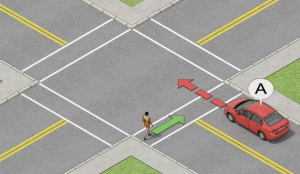
Knowing who has the right of way is crucial for avoiding accidents and keeping traffic flowing smoothly. Here’s a clear breakdown to help you understand common right-of-way situations:
🚦 How to Know Who Has the Right of Way
🛑 1. At Stop Signs (4-Way or All-Way Stops)
- First come, first go: The first car to stop should go first.
- If you stop at the same time:
- The driver on the right has the right of way.
- If you’re directly across from another car and one of you is turning left, the one going straight or turning right goes first.
🔄 2. At Uncontrolled Intersections (No Signs or Lights)
- Yield to traffic from your right.
- If you’re on a smaller road entering a larger one, yield to traffic on the main road.
🚥 3. At Traffic Lights
- Green light: You have the right of way—unless you’re turning left.
- Left turn on green: Yield to oncoming traffic unless you have a green arrow.
- Red light: Stop. You may turn right on red if allowed, but yield to all traffic and pedestrians first.
🚸 4. Pedestrians
- Always yield to pedestrians in crosswalks (marked or unmarked at intersections).
- Yield when turning at an intersection, even if you have a green light.
- Stop when school crossing guards signal.
🚌 5. Emergency Vehicles
- Yield to police, fire, ambulance, or rescue vehicles with lights and sirens.
- Pull over to the right edge of the road and stop until they pass.
🚍 6. School Buses
- Stop when a school bus has red lights flashing and a stop arm extended—in both directions, unless there’s a physical median.
🛣️ 7. Merging or Highway Entrances
- Cars entering the highway must yield to vehicles already on it.
- On ramps: Use acceleration lanes to merge safely, but don’t force your way in.
🔑 Golden Rule: When in doubt, yield. It’s better to be safe than “right.”
As always, you can always improve your driving through courses like the defensive driving program, as this program has many benefits beyond just improving your abilities. It can also lower your insurance prices!


Recent Comments